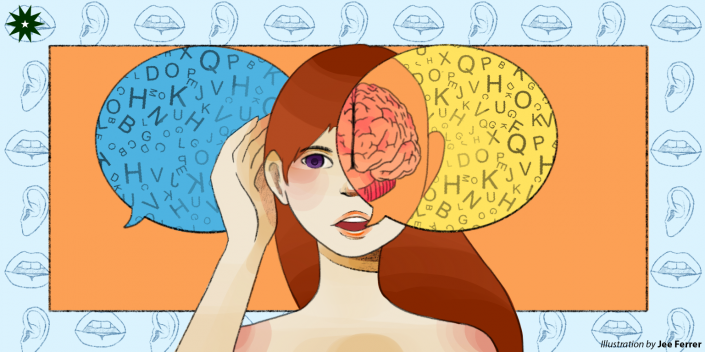The increasingly globalized world has allowed cultures and languages to transcend borders; from Hollywood to K-pop to anime, we consume foreign media often without batting an eye. With more exposure to foreign languages than at any other point in human history, mixed-language contexts are normal scenarios in our everyday lives.
Our exposure to other languages also traces back to the nation’s indigenous and colonial past. Even before the arrival of the Spaniards, the Philippines was already home to diverse languages and dialects. As colonizers came and went, the language systems they left behind blended with our own. Today, there are more than 100 languages in our country.
It is not uncommon to find Filipinos who are proficient in multiple languages—be it a local language like Filipino or Cebuano, or a foreign language like Spanish or Japanese. Even more individuals are developing an interest in learning various languages, especially with the accessibility of self-learning resources such as Duolingo, podcasts, and online courses from universities.
Given this, linguists have been investigating various aspects of language use and development, including a specific area focusing on the mechanisms underlying language acquisition.
Matters of the mind
“The brain is responsible for the entire language acquisition process,” says Dr. Rochelle Lucas, an associate professor from the University’s Department of English and Applied Linguistics, as she lists two specific areas of the brain that are crucial in performing language tasks: Wernicke’s area and Broca’s area.
Wernicke’s area, a region in the brain’s temporal lobe, is involved in language comprehension; while Broca’s area, located in the brain’s frontal lobe, is associated with language production. Although these areas on their own are not enough to facilitate language use—as comprehension and production are not isolated processes—language use further requires the connection of the two areas through a cord-like structure called the arcuate fasciculus, building a bridge between meaning and syntax.
Age is also an important factor in language development, as Lucas explains, “Age is related to the plasticity of the brain; the brain is malleable [and] is more plastic for young children compared to adults.”

Such are the claims of the critical period hypothesis, positing that the optimal time for establishing linguistic competencies is before puberty. Fortunately, even beyond this biological window, adults can still learn new languages, though the process will likely be more challenging. This theory nevertheless remains the subject of much debate; language learning is a complex process, governed by more than just the brain’s physiology.
A spectrum of features
Each language has its own set of attributes and components—from pronounced sounds and written symbols, to the syntax concerning how words are arranged in sentences.
Differences and similarities in language systems play a critical role in learning a second or further language after establishing one’s mother tongue or L1. With the L1 serving as a “base” or source language, connections can be drawn between the L1 and the target language to catalyze language learning.
“If [the L1 is] grounded, then learning L2 is easier because you already know the grammatical structure, phonology, lexicon, syntax of your L1,” Lucas discusses the linguistic interdependence hypothesis. “The languages that we learn may share some of the qualities [of the L1]…so L2 is easier to learn.” This language affinity enables a positive transfer of knowledge from what is familiar to what is yet to be known.
However, learning a new language can still prove difficult particularly if the L2 is immensely different from the L1. Lucas offers several examples, “Mandarin [is] more tonal, [whereas Filipino] is more syllabary. [As for] learning an African language [having] ticks and clicks, we cannot discriminate [such sounds] phonologically because these are not present in our phonological system.”
Orthographic variations can also add to the complexity, Lucas says, highlighting the disparity between stroke-based Chinese characters and Latin script—on which the English and Filipino alphabets are based. She furthers, “Some Filipino speakers of Chinese [or] Japanese may be proficient in speaking, but not really writing [the words].”
A lifelong endeavor
Beyond these technical aspects, however, learning a new language is just as much about attitudes and motivations—being conscious of one’s reasons for learning a language, and mimicking children who are usually “not afraid to take risks [and] not afraid to learn”.
Whether enhancing one’s abilities in an already-familiar language or adding a new language to one’s skill set, Lucas shares that language learning is a continuous process, “We still learn so much about our language as we grow…You cannot say it’s [sufficiently acquired] because learning a language never stops.”
Becoming adept at a language, or multiple languages for that matter, is a challenging process, but constant use and exposure can cultivate one’s linguistic abilities. We can improve our command of language everyday by exercising what we know into new contexts—such as in the workplace or communicating with people from different cultures—discovering nuances in the way we wield the language as we communicate.
